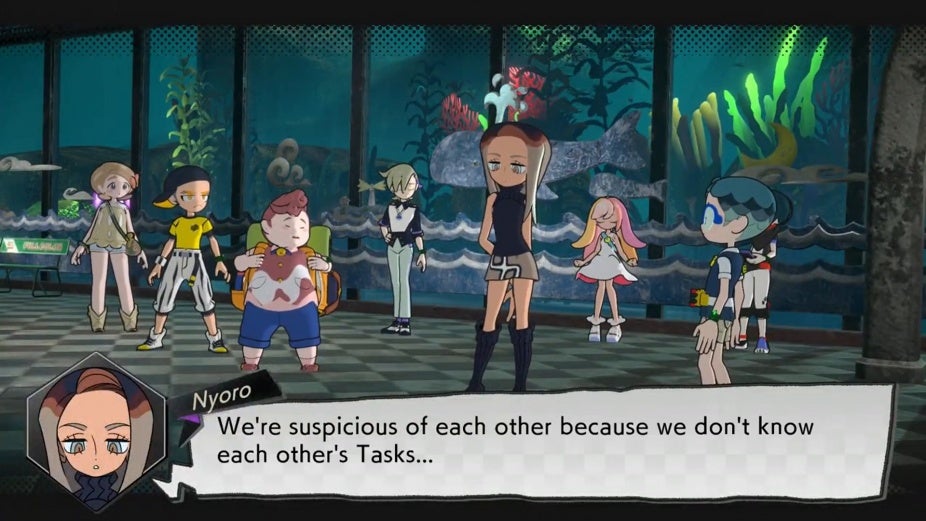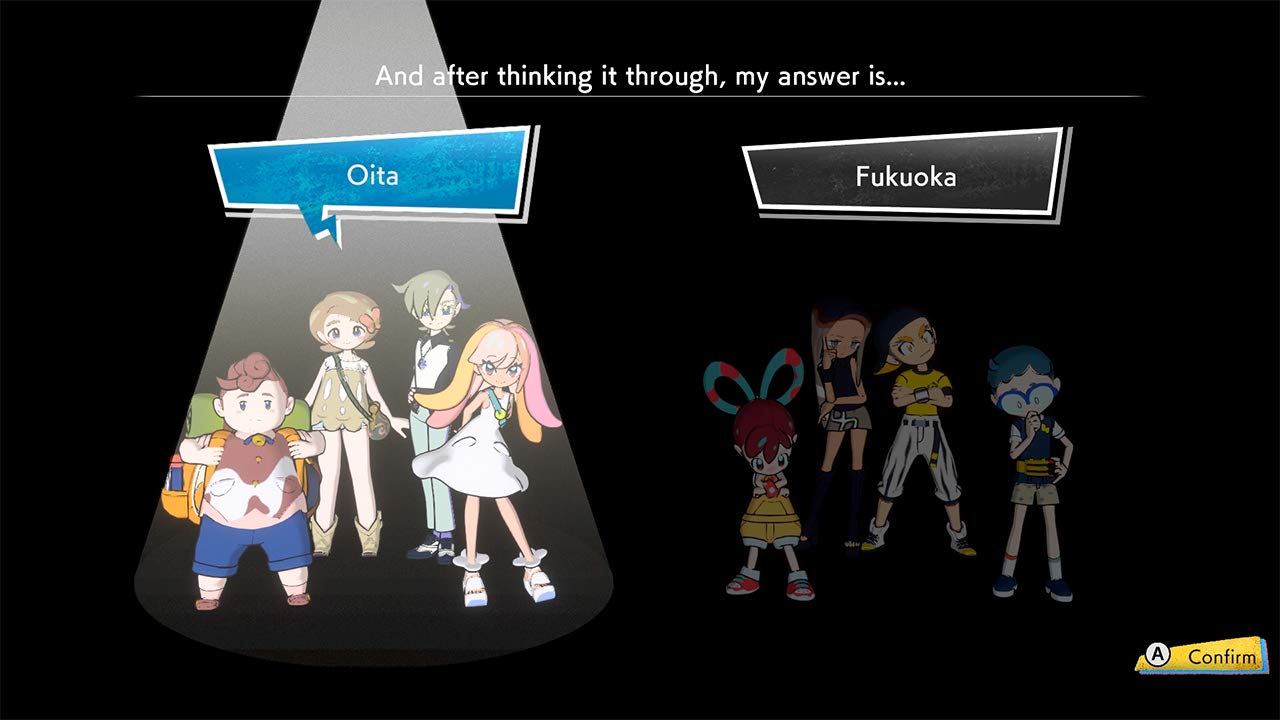Meet The Go-Getters Club, a grade school class of 11 children who are on their way to Kamakura near Tokyo for a school trip when a meteor strikes nearby. When they come to, the children leave pods (!) and find themselves in a theme park (!!!) underwater (!!!!) where a flying mascot called Pielope tells them they have to play a death game to make it out alive. It’s an important spoiler of sorts to note that the death game, once the driving force in the game’s marketing, comprises the first half hour of nearly 20, so if you go in expecting another Danganronpa, this is a likely deliberate misdirect. Instead, upon their successful escape everyone wakes up in Kagoshima, on the other end of Japan has to discover that everything seems suspiciously quiet and unkempt, and that monsters are roaming the land. Unwilling to admit that this means what it usually means in videogames, the Go-Getters Club decides to walk across the country back home to Tokyo. When a game starts with grade schoolers facing off against each other in a battle royale, you can guess the rest isn’t going to be a nice hike through the Japanese countryside, either. Ghosts, killer robots, aliens and cultists are just some of what you can expect in World’s End Club, as the Go-Getters Club slowly uncovers what exactly took place during their absence. To top things off, the children begin to develop superpowers one by one, powers you’ll use during World’s End Club sporadic 2D platforming sequences. The platforming is so simple it led players of the previously released Apple Arcade version to surmise that World’s End Club must be a game for children. I reject that and instead invite you to consider the following - making gameplay is hard. This is a game by a narrative-focused company. The ideas for each superpower and engaging ways to use them are neat, I just think they’re simple because they’re neither the focus of the game nor its developers. Personally I think it would’ve been fine to cut these bits and just commit to World’s End Club as a visual novel, but that’s mostly because the platforming teaches you via trial and error. Take a hit and it’s game over, so, just like in games with those infuriating stealth sequences where being spotted means an immediate do-over, you’ll die, hear a weird squeaky game over sound that will follow you into your dreams, and try again, because the solution is likely less complicated than you initially thought. Or because a hole suddenly appeared in front of you to trip you up. Grr! Like many games of this kind that are trying to build a mystery, you’ll come by most of the plot via exposition dump. Across the story, someone will always come along and just spill the beans - unveil the evil plan, explain what’s going on. That in itself is a slightly tedious method of storytelling, but whereas something like 13 Sentinels: Aegis Rim drops its hints far in advance, World’s End Club will just get a macguffin in there - “oh by the way, this mystery is explained by this thing you’ve previously never heard of that suspiciously works in all the ways we need to solve our problem.” World’s End Club often made me laugh with how it leaned into the most absurd explanation with its whole body, just so it could actively resist being predictable. Like Uchikoshi said, it’s memorable at any cost, but that approach sure isn’t cohesive worldbuilding. At certain points, the story diverges based on your choices, but you will play those alternative paths further down the line. The narrative device that makes this possible seems a bit hackneyed to me. It turns out these points didn’t bother me at all, because World’s End Club seasons everything with a generous helping of concentrated anime-ness. The Go-Getters Club is just so incredibly cute I fell in love with each of them. Some of them are your standard anime tropes, like Mowchan, the fat kid who only thinks about food, or Aniki (‘big brother’), the cool but aloof type. Their design is super cute, and I want them as plushes and Nendroids, but they’re also just the kind of friends I think many of us dream of, the kind that sticks together through thick and thin. They have their own chant! And their own Go-Getters song! As usual with anime-type stories, emotions are running high. There’s a lot of crying and surprised exclamations, and generally a lot of interaction between all of the Go-Getters. World’s End Club has “camp” sequences, a period of rest where you can talk to each character and take stock of what you’ve learned. I dare you not to love each character after these. It’s essentially likable for reasons similar to Persona 5 Strikers - a group of friends goes on a trip through Japan to fight the supernatural. Plus the presentation is fantastic - the relatively simple but vibrant backgrounds represent each destination you’ll visit on your way, and the UI conveys a real sense of energy. Upon gaining a super power, each character has a lovely little transformation sequence, and while the whole game is sparingly animated, a lot of work was put into making those animations fun enough it won’t bother you to see them a lot. I’ve also really enjoyed the Japanese dub (the game also comes with an English dub), which features a lot of women voicing boys, which is endlessly fascinating to me, among them Dangaronpa alum Megumi Ogata, who you also might know as Shinji Ikari from Neon Genesis Evangelion. In essence, even if the story beats were a bit too over the top for my taste, you truly won’t see any of it coming, and I thoroughly enjoyed the journey thanks to World’s End Club’s lovable cast.




